
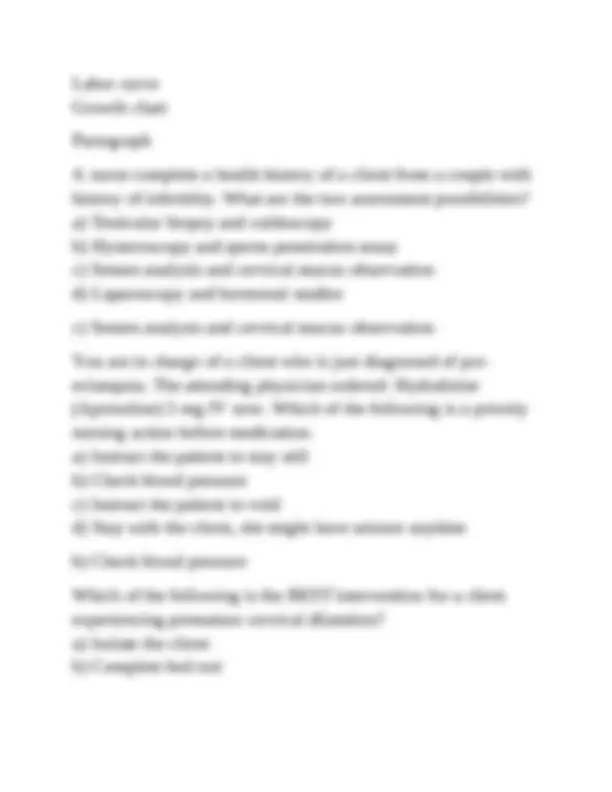
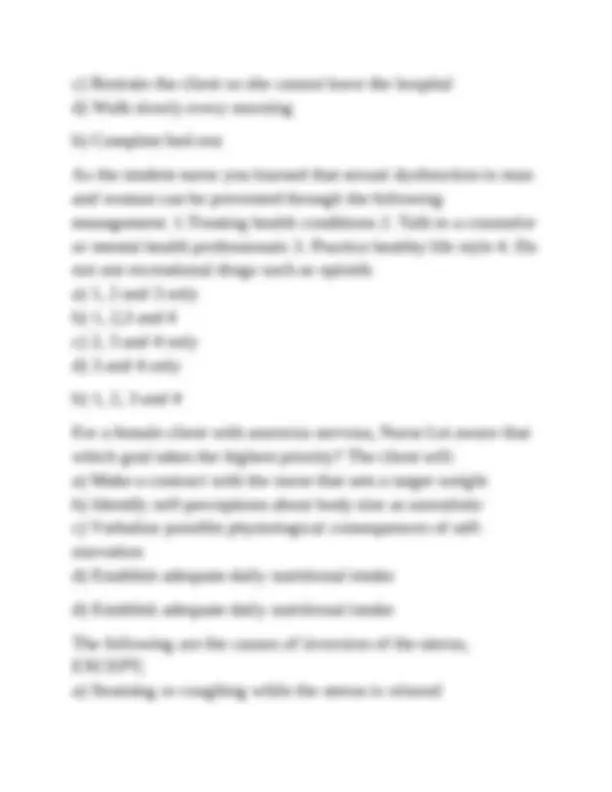
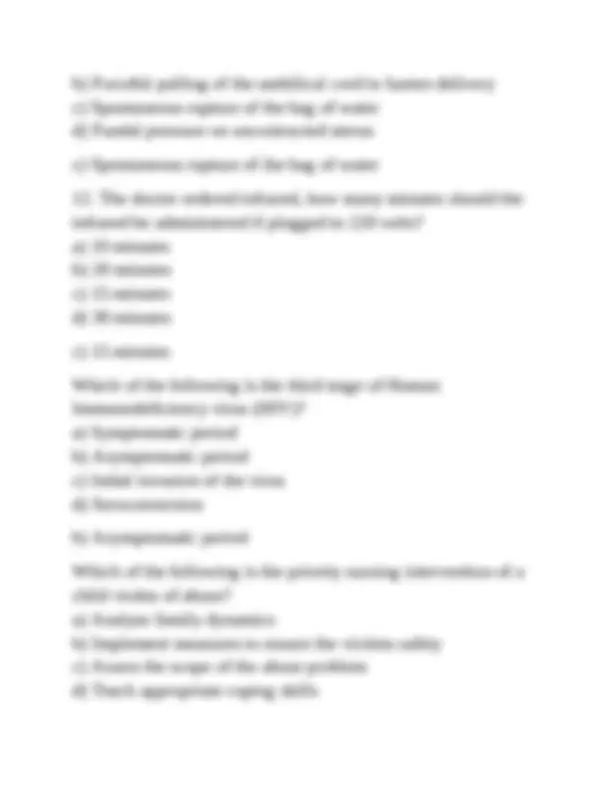
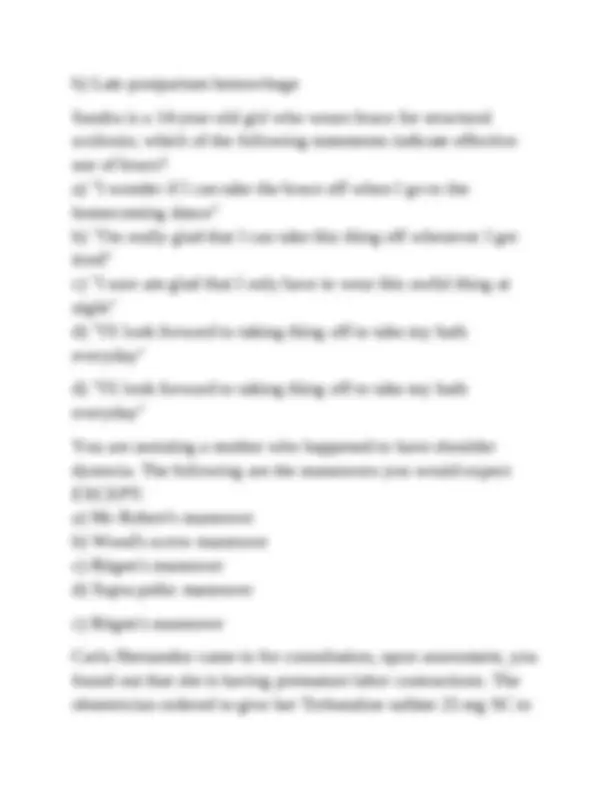
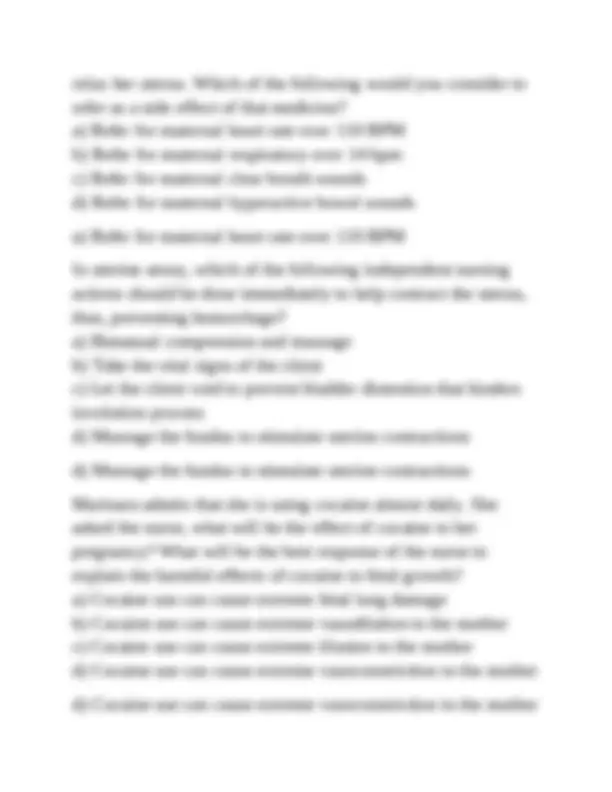
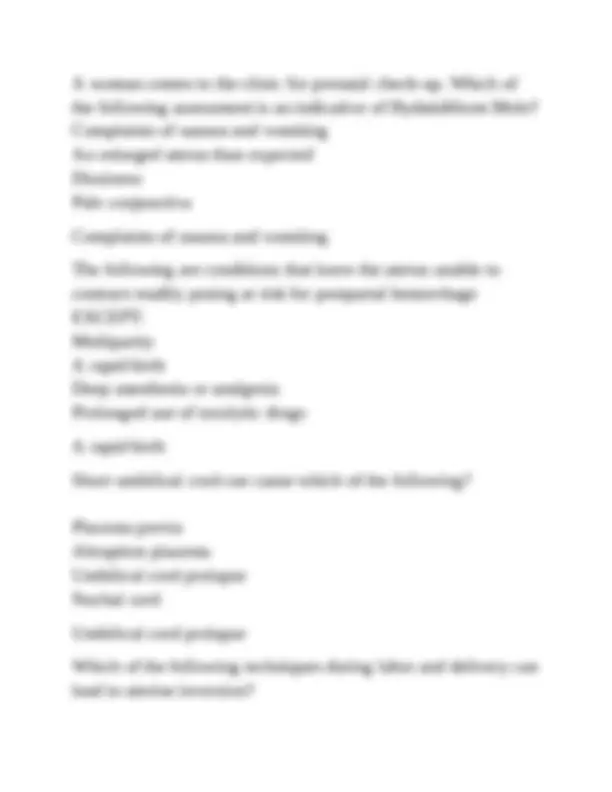
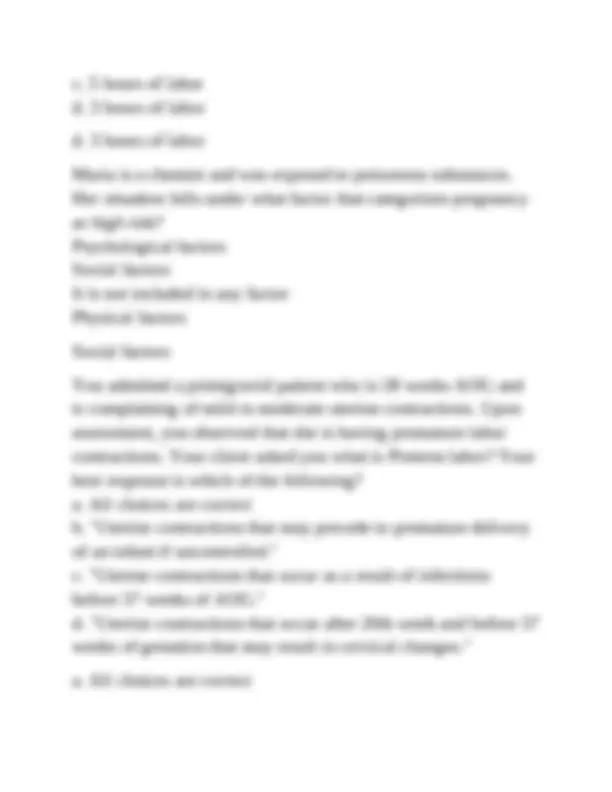
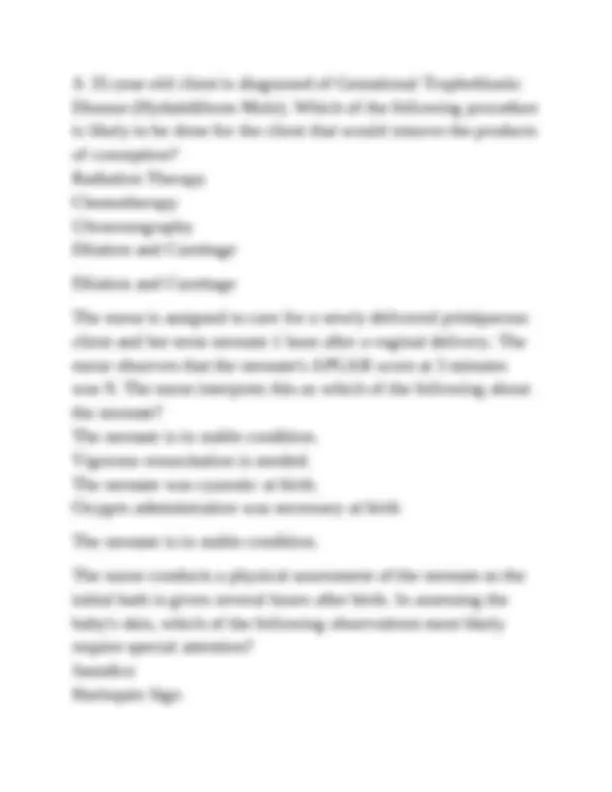
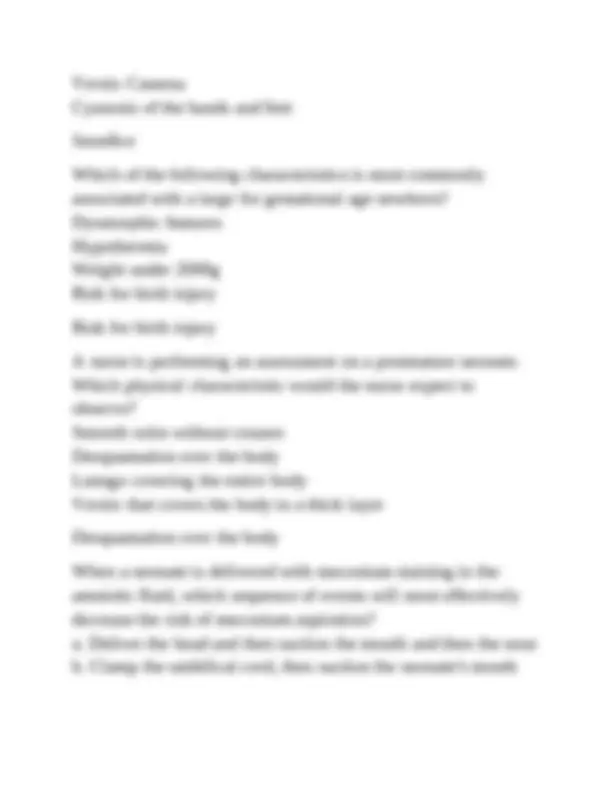
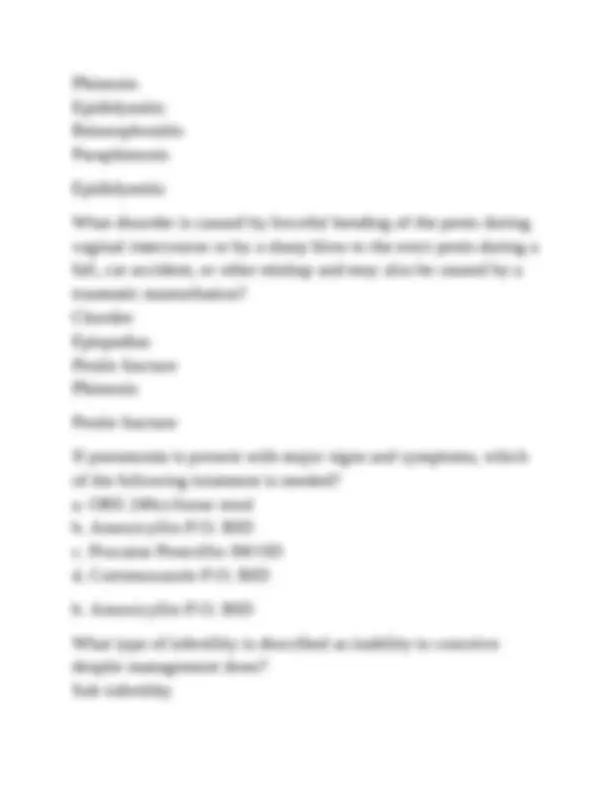



Study with the several resources on Docsity

Earn points by helping other students or get them with a premium plan


Prepare for your exams
Study with the several resources on Docsity

Earn points to download
Earn points by helping other students or get them with a premium plan
Community
Ask the community for help and clear up your study doubts
Discover the best universities in your country according to Docsity users
Free resources
Download our free guides on studying techniques, anxiety management strategies, and thesis advice from Docsity tutors
A collection of questions and answers related to the care of mothers and children at risk or with problems. It covers various topics, including abnormal placental implantation, postpartum hemorrhage, and common conditions affecting mothers and children. Useful for students studying maternal and child health, providing a comprehensive overview of key concepts and clinical scenarios.
Typology: Exams
1 / 19

This page cannot be seen from the preview
Don't miss anything!












NCM 109 Care of Mother & Child at-risk or w/ Problems Acute & Chronic Questions With Complete Solutions What abnormal placental implantation is described as, "chorionic villi that penetrates beyond the myometrium into the entire uterine wall and possibly to other adjacent organs such as the bladder"? Placenta circumvallate Placenta Increta Placenta Accreta Placenta Percreta Placenta Percreta This condition is commonly experienced as one-sided, lower abdominal pain associated with ovulation, depending on which side release of the egg occurs, sometimes accompanied by slight vaginal bleeding or discharge. Polycystic Ovarian Syndrome (PCOS) - Unicomuate Mittelschmerz Post castration syndrome Mittelschmerz
Among the abnormal placenta, what is described as the "placenta that has one or more accessory lobes connected to the main placenta by blood vessels"? Vasa previa Velamentous insertion of the cord Battledore placenta Placenta succenturiate Placenta succenturiate A mother brought her 4 years old son in the health center. Upon assessment the nurse observed that the child has pus draining from his eye and has mouth ulcers. The following are the management for this child EXCEPT Treat mouth ulcers with gentian violet Treat eye infection with tetracycline eye ointment Give Vitamin A treatment Follow up should be done after 1 week Follow up should be done after 1 week The World Health Organization (WHO) recommend the use of this tool to monitor the progress of labor, identify and intervene in cases of abnormal labor. Which of the following has been established universally as the "gold standard" labor monitoring tool for maternal and fetal well-being? Partograph Gantt chart
c) Restrain the client so she cannot leave the hospital d) Walk slowly every morning b) Complete bed rest As the student nurse you learned that sexual dysfunction in man and woman can be prevented through the following management: 1.Treating health conditions 2. Talk to a counselor or mental health professionals 3. Practice healthy life style 4. Do not use recreational drugs such as opioids a) 1, 2 and 3 only b) 1, 2,3 and 4 c) 2, 3 and 4 only d) 3 and 4 only b) 1, 2, 3 and 4 For a female client with anorexia nervosa, Nurse Lei aware that which goal takes the highest priority? The client will: a) Make a contract with the nurse that sets a target weight b) Identify self-perceptions about body size as unrealistic c) Verbalize possible physiological consequences of self- starvation d) Establish adequate daily nutritional intake d) Establish adequate daily nutritional intake The following are the causes of inversion of the uterus, EXCEPT; a) Straining or coughing while the uterus is relaxed
b) Forceful pulling of the umbilical cord to hasten delivery c) Spontaneous rupture of the bag of water d) Fundal pressure on uncontracted uterus c) Spontaneous rupture of the bag of water
c) Supine position Which of the following type of anemia has enlarged, yet immature red blood cell? a) Sickle- cell anemia b) Folic-Acid deficiency anemia c) All of the choices are correct d) Iron deficiency anemia b) Folic-Acid deficiency anemia A client was admitted due to premature rupture of the membrane. Which of the following is a possible complication of PROM? a. Placenta Previa b. Gestational diabetes c. Umbilical cord prolapse d. Preeclampsia c. Umbilical cord prolapse Retained placental fragments have been associated with pregnancy complications, this is the most common cause of bleeding in which of the following types of postpartum hemorrhage? a) Class IV hemorrhage b) Late postpartum hemorrhage c) Class III hemorrhage d) Early postpartum hemorrhage
b) Late postpartum hemorrhage Sandra is a 14-year-old girl who wears brace for structural scoliosis; which of the following statements indicate effective use of brace? a) "I wonder if I can take the brace off when I go to the homecoming dance" b) "I'm really glad that I can take this thing off whenever I get tired" c) "I sure am glad that I only have to wear this awful thing at night" d) "I'll look forward to taking thing off to take my bath everyday" d) "I'll look forward to taking thing off to take my bath everyday" You are assisting a mother who happened to have shoulder dystocia. The following are the maneuvers you would expect EXCEPT: a) Mc Robert's maneuver b) Wood's screw maneuver c) Ritgen's maneuver d) Supra pubic maneuver c) Ritgen's maneuver Carla Hernandez came in for consultation, upon assessment, you found out that she is having premature labor contractions. The obstetrician ordered to give her Terbutaline sulfate 25 mg SC to
A woman comes to the clinic for prenatal check-up. Which of the following assessment is an indicative of Hydatidiform Mole? Complaints of nausea and vomiting An enlarged uterus than expected Dizziness Pale conjunctiva Complaints of nausea and vomiting The following are conditions that leave the uterus unable to contract readily posing at risk for postpartal hemorrhage EXCEPT: Multiparity A rapid birth Deep anesthesia or analgesia Prolonged use of tocolytic drugs A rapid birth Short umbilical cord can cause which of the following? Placenta previa Abruption placenta Umbilical cord prolapse Nuchal cord Umbilical cord prolapse Which of the following techniques during labor and delivery can lead to uterine inversion?
a. Massaging the fundus to encourage the uterus to contract. b. Tugging strongly on the umbilical cord to deliver the placenta and hastening placental separation. c. Applying of fundal pressure to assist the mother in bearing down during delivery of the fetal head. d. Applying light traction when delivering the placenta that has already detached from the uterine wall. b. Tugging strongly on the umbilical cord to deliver the placenta and hastening placental separation. Which of the following client/s are at risk for developing placenta previa?
c. 5 hours of labor d. 3 hours of labor d. 3 hours of labor Maria is a chemist and was exposed to poisonous substances. Her situation falls under what factor that categorizes pregnancy as high risk? Psychological factors Social factors It is not included in any factor Physical factors Social factors You admitted a primigravid patient who is 28 weeks AOG and is complaining of mild to moderate uterine contractions. Upon assessment, you observed that she is having premature labor contractions. Your client asked you what is Preterm labor? Your best response is which of the following? a. All choices are correct b. "Uterine contractions that may precede to premature delivery of an infant if uncontrolled." c. "Uterine contractions that occur as a result of infections before 37 weeks of AOG." d. "Uterine contractions that occur after 20th week and before 37 weeks of gestation that may result in cervical changes." a. All choices are correct
A 35-year-old client is diagnosed of Gestational Trophoblastic Disease (Hydatidiform Mole). Which of the following procedure is likely to be done for the client that would remove the products of conception? Radiation Therapy Chemotherapy Ultrasonography Dilation and Curettage Dilation and Curettage The nurse is assigned to care for a newly delivered primiparous client and her term neonate 1 hour after a vaginal delivery. The nurse observes that the neonate's APGAR score at 5 minutes was 9. The nurse interprets this as which of the following about the neonate? The neonate is in stable condition. Vigorous resuscitation is needed. The neonate was cyanotic at birth. Oxygen administration was necessary at birth The neonate is in stable condition. The nurse conducts a physical assessment of the neonate as the initial bath is given several hours after birth. In assessing the baby's skin, which of the following observations most likely require special attention? Jaundice Harlequin Sign
c. Deliver the thorax, then suction the mouth d. Deliver the thorax, then suction the nose then the mouth a. Deliver the head and then suction the mouth and then the nose What is the chronic irreversible complication of hyperbilirubinemia? Kernicterus Hypobilirebunemia Abnormal Gaze Sensorineural deafness Kernicterus Ms. S delivers a 6 lb 5 oz (2863 g) boy. Because his serum bilirubin level is elevated, the baby is receiving phototherapy. To meet the safety needs of the baby while he is undergoing phototherapy, the nurse would: Keep the baby clothed Limit fluid intake Provide eye and genital shields Make sure the light is not closer than 24 inches Provide eye and genital shields While walking around Puting Kahoy a man approach Bea and suddenly exposed his genitals, what type of sexual alteration is this? Necrophilia Zoophilia
Exhibitionist Voyeurism Exhibitionist May, 4 years old, was brought to the health center because of ear pain. When the community nurse further assessed the patient, he observed that pus is draining from the ear. The mother verbalized that she noticed the discharge for 3 weeks already. How will the nurse classify her condition? Acute ear infection No ear infection Mastoiditis Chronic ear infection Chronic ear infection Which of the following is NOT a general danger sign? a. Lethargy/difficult to awaken b. Convulsion c. Difficulty of breathing d. Inability to drink or breastfeed c. Difficulty of breathing Which of the following is an inflammation of the male reproductive system where there is inguinal and scrotal pain, fever, and tenderness of the affected part? Urinalysis result of patient with this condition shows bacteria and WBCs. Treatments for this includes antibiotics and symptomatic relief.
Sterility Secondary infertility Primary infertility Sterility